Welcome to our comprehensive resource on CV Joint and Drive Shaft components. These critical parts of your vehicle's drivetrain ensure smooth power transmission from the engine to the wheels, enabling seamless turns and consistent performance. Understanding their specifications, maintenance, and functionality is essential for any car owner or automotive enthusiast.
A Constant Velocity (CV) Joint is a mechanical component that connects the drive shaft to the wheels, allowing for power transfer at constant speeds while accommodating variations in angle and length. This is crucial for front-wheel drive vehicles, but also used in rear-wheel and all-wheel drive systems.
The drive shaft, often referred to as the propeller shaft, is a tubular component that transmits torque from the transmission to the differential, which then powers the wheels. It must be durable and balanced to handle rotational forces and vehicle dynamics.
Our CV Joints and Drive Shafts are engineered to meet OEM standards and exceed performance expectations. Below are detailed specifications presented in lists and tables for clarity.
| Parameter | Details |
|---|---|
| Material | High-Strength Steel or Aluminum Alloy |
| Length | Custom lengths from 500 mm to 2500 mm, tailored to vehicle requirements |
| Diameter | 30 mm to 100 mm, depending on torque needs |
| Balance Tolerance | Within 10 g-cm at production to minimize vibrations |
| Maximum RPM | Up to 10,000 RPM for high-performance applications |
| Weight | Varies by material and size; steel shafts weigh 5-20 kg, aluminum 3-15 kg |
| Surface Treatment | Phosphate coating or powder coating for corrosion resistance |
CV joints and drive shafts are utilized in various vehicles, including sedans, trucks, and off-road machines. Their benefits include smooth operation, durability, and efficient power transfer. Regular inspection can prevent failures and extend vehicle life.
What are the signs of a failing CV joint?
Common symptoms include clicking noises during turns, grease on the inside of the wheel, vibration while accelerating, and difficulty steering. If you notice these, inspect the CV joint immediately to avoid further damage.
How often should drive shafts be replaced?
Drive shafts typically last the lifetime of the vehicle under normal conditions, but they may require replacement every 150,000 to 200,000 miles due to wear, corrosion, or accident damage. Regular maintenance checks are recommended.
Can I replace a CV joint myself?
Yes, with proper tools and mechanical knowledge, replacing a CV joint is feasible. However, it involves disassembling the drive shaft and requires precision. For most owners, professional installation is advised to ensure safety and correctness.
What causes drive shaft vibration?
Vibration often results from imbalance, worn universal joints, misalignment, or damage to the shaft. It's crucial to address this promptly, as it can lead to other drivetrain issues and unsafe driving conditions.
Are CV joints and drive shafts covered under warranty?
Our products come with a standard warranty of 2 years or 50,000 miles, whichever comes first, covering defects in materials and workmanship. Always check the specific terms for your purchase.
How do I choose the right CV joint for my vehicle?
Select based on your vehicle's make, model, year, and drivetrain type. Refer to our compatibility charts or consult with our support team to ensure a perfect match for optimal performance.
What maintenance do CV joints and drive shafts require?
Regularly inspect for leaks, cracks, or wear in the boots, and ensure proper lubrication. For drive shafts, check for balance and alignment during routine service intervals to prevent premature failure.
Can aftermarket CV joints perform as well as OEM parts?
High-quality aftermarket parts, like ours, are designed to meet or exceed OEM specifications. They undergo rigorous testing for durability and performance, making them a reliable and often more affordable alternative.
What is the difference between a CV joint and a U-joint?
A CV joint maintains constant velocity during angle changes, ideal for front-wheel drive, while a U-joint (universal joint) allows for angular movement but may cause speed fluctuations, commonly used in rear-wheel drive systems.
How does temperature affect CV joint performance?
Extreme temperatures can degrade the grease and boot material. Our joints are rated for broad temperature ranges, but in very cold or hot climates, more frequent inspections may be necessary to ensure integrity.







